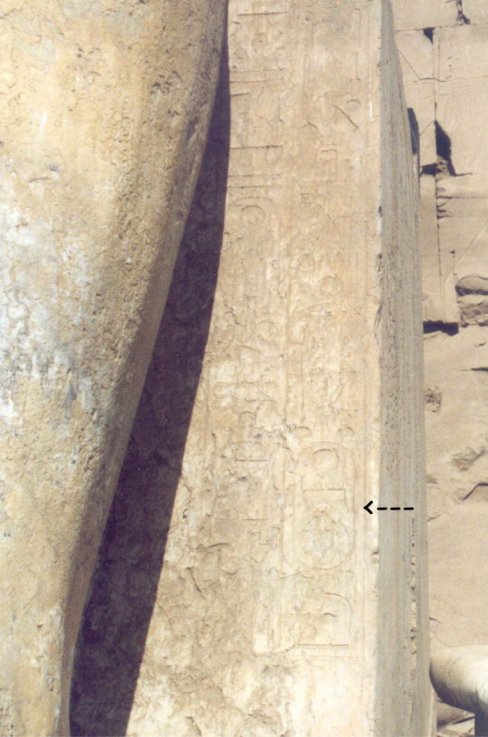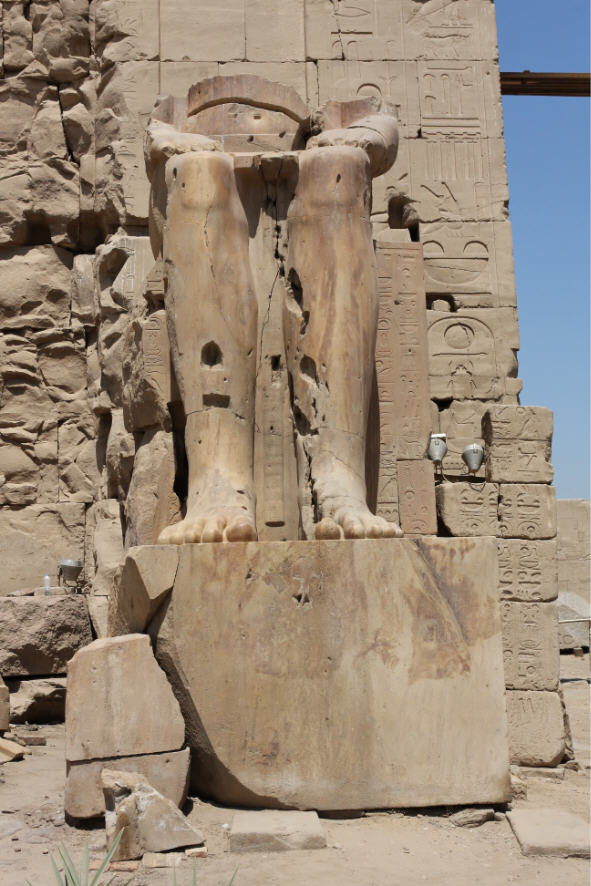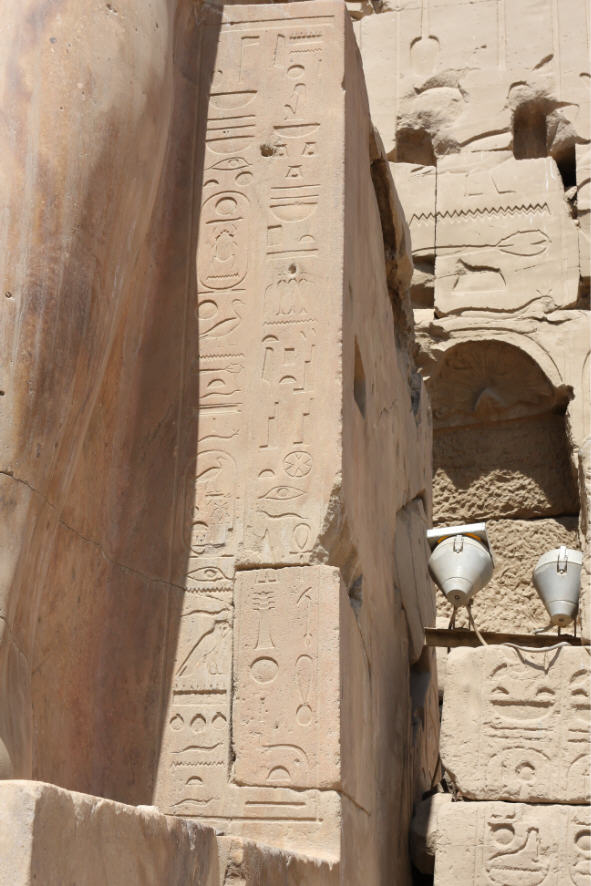|
Maat-ka-Ra Hatshepsut |
last update:
03.01.2012
|
| |
Karnak - 8th Pylon |
|
| |
Statues in front of the South Side of the 8th Pylon |
|

| In front of the 8th Pylon six colossal statues, among them two
seated giant statues made of limestone (one before each wing of the pylon) had
been erected in antiquity. Today, only the remains of three statues in front of
the west wing and one statue together with two basis in situ in front of the
east wing have been preserved (s. a. Porter&Moss II, 1994, p. 176 and plan XIV). |
| Here in front of the left wing the following statues (localization and
identification after Porter, Moss, 1994) had been erected: |
- on the left, statue
M, Amenhotep
II, with a restoration text of Thutmosis IV., beside its right leg
there is a small statue of the queen Tia, the mother of the Thutmosis IV.
|
|
- in the middle, statue N, made of limestone (H: 884; W:222; D:429 cm),
showing the cartouche of Amenhotep I (Djoser-ka-Ra) and a "restoration
text" dating to year 22 of the reign of Thutmosis III
|
|
- on the right, the statue O, quartzite, inscribed with Thutmosis II (Aa-cheper-en-Ra) and a "renewal text"
dated from regnal year 42 of Thutmosis III; on the exterior directly besides the
right leg there is a small statue of the "Sister of the King" Mut-nefret,
mother of Thutmosis II.
|

| Above the right wing viewed from the south side of 8th
Pylon with the remainders of statue P made of limestone (after Porter, Moss,
1994; H: not
measurable, W: 213; D: 420cm), inscribed with Thutmosis II and a "renewal text"
dating from year 22 of Thutmosis III. A part of the head (see photo
below) of this severely destroyed statue lies directly at its feet - one
easily recognizes the right ear and the nms-headdress.
|
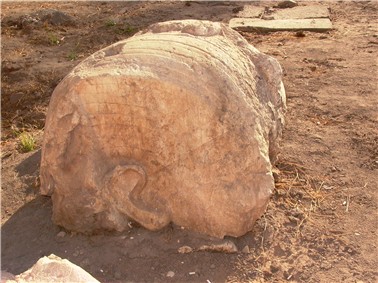
| As far as it can be decided from the condition of the statues
all of them wear a pleated kilt of different length, the royal apron and the
hands are laying flat on the thighs, only statue N is holding a cloth in the
right hand (see below). |
| Loeben (2001) examined the statues and described the inscriptions in
his thesis. The statue N before the left, western wing of the pylon has
survived in a much better condition. The statue (see left photo below) shows
a seated king, both hands on the lap. The right hand is clenched to a fist and holds a cloth, the left hand is
put flat on the thigh. With exception of the face the statue is still in
a good condition. The rear column of the statue is not inscribed, on the other hand
there are inscriptions on the buckle of the belt and along both legs
(Loeben, 2001).
|
The right photo shows parts of the inscriptions beside the left leg. The cartouche
of Thutmosis III is to be seen quite well in the outside register (see arrow).
The left register shows another cartouche which is to be detected above that of Thutmosis
III (direction north-northwest). However, due to the structure of the stone
the signs are hardly to be deciphered. During my inspection of the statue in January 2002 I could detect the characters of
Ra and Ka (the "Djoser" was not recognizable any longer).
|
|
Investigations by Loeben resulted without any doubts that the text
inscribed into the belt of statue N has been modified in antiquity and
that the original text was completely replaced. Further modifications
were done in the Amarna period and during the restorations thereafter.
|
|
The "renewal text" beside the left leg (shown above) ,- the texts on the
front side of the throne are obviously identical - reads (after Loeben):
"Beloved by Amun, Lord of the thrones of the Two Lands (=
Theben), (is) the Perfect God, the Lord of the Two Lands,
+Sr-kA-Ra,
bodily son of Ra, Amenhotep (I).
Now, this statue was made perfect in the regnal year 22 under the majesty of the king of
Upper and Lower Egypt, Men-cheper-Ra (= Thutmosis III), who may
live for ever."
|
| Due to Loeben, the new realization that the text on the buckle of the
belt does not represent the original inscription, throws new light also on the inscriptions on the
front of the throne, i.e. the "renewal inscriptions". According to Loeben the use of the
phrase "make perfect" (instead of "restoring or
renewing") is quite remarkable, its use is limited to the restoration
of statues at the 8th Pylon, where all statues exhibit an appropriate note.
With regard to the two limestone statues N and P, Thutmosis III claimed
the responsibility for "making perfect [them] in the year 22" for
himself.
|
| In both statues Loeben sees original representations of Hatshepsut which
were preserved by Thutmosis III because of their impressing appearance.
Instead of destroying the statues Thutmosis III re-inscribed or
"made them perfect" by dedicating them to his ancestors.
|
|
Based on the investigations of Loeben Eaton Kraus (1998) interprets the
"restoration texts" of year 22 (that is the first year of his autocracy) as the earliest date
of the persecution of Hatshepsut.
|
|
Loeben himself does not agree to this conclusion. He points out that it is quite
possible, that Thutmosis III "has antedated" the action of "making [them]
perfect". Furthermore, Loeben points to the possibility that the work (with
exception of the restoration done in year 42) might have been executed by the
successor of Thutmosis III, Amenhotep II, who then "antedated" the "restoration"
into the reign of his father - just to honor him. This is quite plausible since
the decoration shows that Amenhotep II has focused his attention to the 8th
Pylon. |
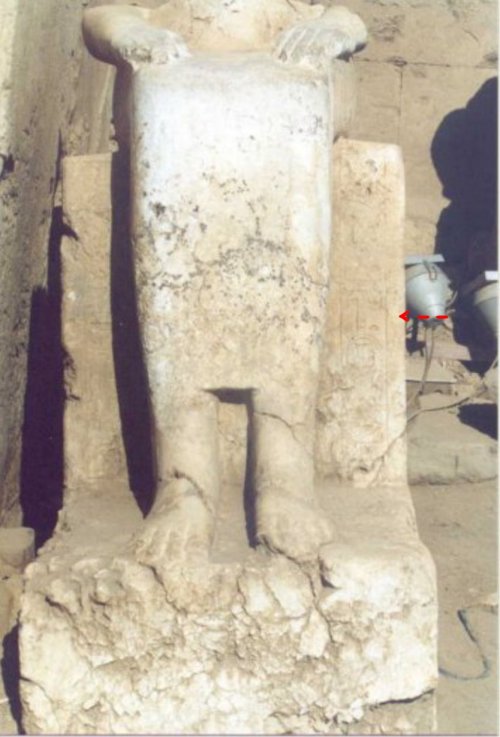
The is a lower part of a smaller statue standing on the right
side of giant statue N. This small statue shows besides the left leg and
above a cartouche which is not readable anymore the title of a "God's
Wife"  (see photo above, red arrow). If the reading applies, its results inevitably the question, which "God's wife" is
meant here - perhaps Neferu-Ra (if the giant statue left is that of
Hatshepsut).
(see photo above, red arrow). If the reading applies, its results inevitably the question, which "God's wife" is
meant here - perhaps Neferu-Ra (if the giant statue left is that of
Hatshepsut).
|
| Porter&Moss (1994) assigns the small statue of the Merit- Amun II, the daughter of Thutmosis
III and Merit-Ra
Hatshepsut, and wife of the Amenhotep II, who - due to Sander Hansen - actually carried the title of a "God's wife". |
| Since this small statue stands directly beside that of Hatshepsut (statue N), which was re-assigned
to Amenhotep I, this small statue may represent also his mother Ah-mose-
Nefertari - who was not only one of the first "God's wives", but one admired in later time almost
as a "prototype" of all "God's wives". Furthermore, Ah-mose- Nefertari
became deified together with her son, Amenhotep I. Today, the upper part
is exhibited in the British Museum and there the small statue is assigned
to Ah-mose-Nefertari to (a photo of the upper part is presented on the page
about the history of the God' wives).
|
| East (right) of statue N another colossal statue (statue O;
below left photo) had been erected on the western wing of the pylon which shows
again an enthroned king. Only the lower part of the statue made of quartzite has survived.
The statue is dedicated to Thutmosis II (see below, right photo) and bears a restoration text of Thutmosis III dated into year 42
(see also Porter&Moss II, 1994, p. 176). |
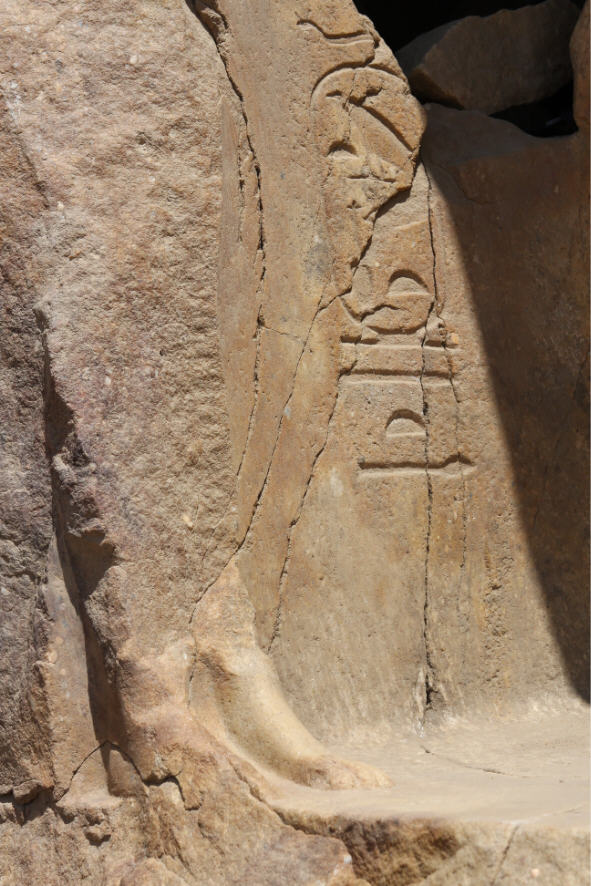 |
|
Beside the right leg of the enthroned king there
are the remains (feet) of a small figure which is identified by the inscription
left of the body as "sAt nswt mrt=f =
the beloved daughter of the king," Mut-nefret (= Mut-nofret). |
| The representation of Mut-nefret and the fact that the statue
bears a "restoration text" suggest that the statue did not originally show
Thutmosis II and his mother but Thutmosis I and his queen. |
|
In the course of the persecution of Hatshepsut her statues were re-assigned.
|
|




